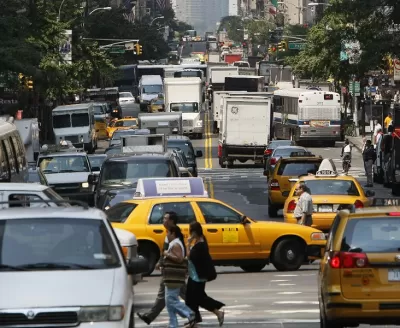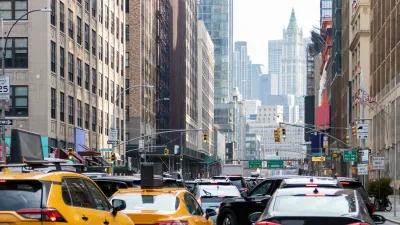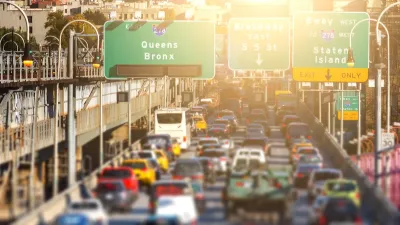The program would be the first cordon pricing scheme in the United States.

The U.S. Department of Transportation approved environmental reviews for New York City’s congestion pricing plan, clearing one of the city’s biggest obstacles to implementing the program.
As Daniel C. Vock explains in Route Fifty, the program, also known as cordon pricing, could raise up to $1 billion per year, much of which would go toward funding the city’s transit system. “The cordoned-off area would include all of Manhattan south of 60th Street. Tolls are expected to be between $9 and $23 per vehicle, but local officials have not yet decided the rate.”
Supporters of congestion pricing say the plan would boost public transit funding, improving service for transit commuters, and reduce congestion on roads, improving commutes for drivers.
While no other U.S. city uses congestion pricing yet, the practice has shown positive results in London, Stockholm, and other international cities. “Tiffany-Ann Taylor, vice president for transportation at the Regional Plan Association (RPA), said the effects on downtown streets should be quick to see once the tolling plan is put into place, even if it takes a few years for physical improvements to the subway system to take shape.”
Some local politicians are wary of the plan, saying it penalizes New Jersey workers who commute into the city. Taylor counters the claim, saying that “The fact of the matter is the folks who are commuting to New Jersey are mostly coming in through public transit … Folks who live in New Jersey and other parts of the region actually are benefiting directly from the program.”
FULL STORY: Congestion Pricing in Manhattan Clears Federal Hurdle

Alabama: Trump Terminates Settlements for Black Communities Harmed By Raw Sewage
Trump deemed the landmark civil rights agreement “illegal DEI and environmental justice policy.”

Planetizen Federal Action Tracker
A weekly monitor of how Trump’s orders and actions are impacting planners and planning in America.

The 120 Year Old Tiny Home Villages That Sheltered San Francisco’s Earthquake Refugees
More than a century ago, San Francisco mobilized to house thousands of residents displaced by the 1906 earthquake. Could their strategy offer a model for the present?

In Both Crashes and Crime, Public Transportation is Far Safer than Driving
Contrary to popular assumptions, public transportation has far lower crash and crime rates than automobile travel. For safer communities, improve and encourage transit travel.

Report: Zoning Reforms Should Complement Nashville’s Ambitious Transit Plan
Without reform, restrictive zoning codes will limit the impact of the city’s planned transit expansion and could exclude some of the residents who depend on transit the most.

Judge Orders Release of Frozen IRA, IIJA Funding
The decision is a victory for environmental groups who charged that freezing funds for critical infrastructure and disaster response programs caused “real and irreparable harm” to communities.
Urban Design for Planners 1: Software Tools
This six-course series explores essential urban design concepts using open source software and equips planners with the tools they need to participate fully in the urban design process.
Planning for Universal Design
Learn the tools for implementing Universal Design in planning regulations.
Clanton & Associates, Inc.
Jessamine County Fiscal Court
Institute for Housing and Urban Development Studies (IHS)
City of Grandview
Harvard GSD Executive Education
Toledo-Lucas County Plan Commissions
Salt Lake City
NYU Wagner Graduate School of Public Service





























